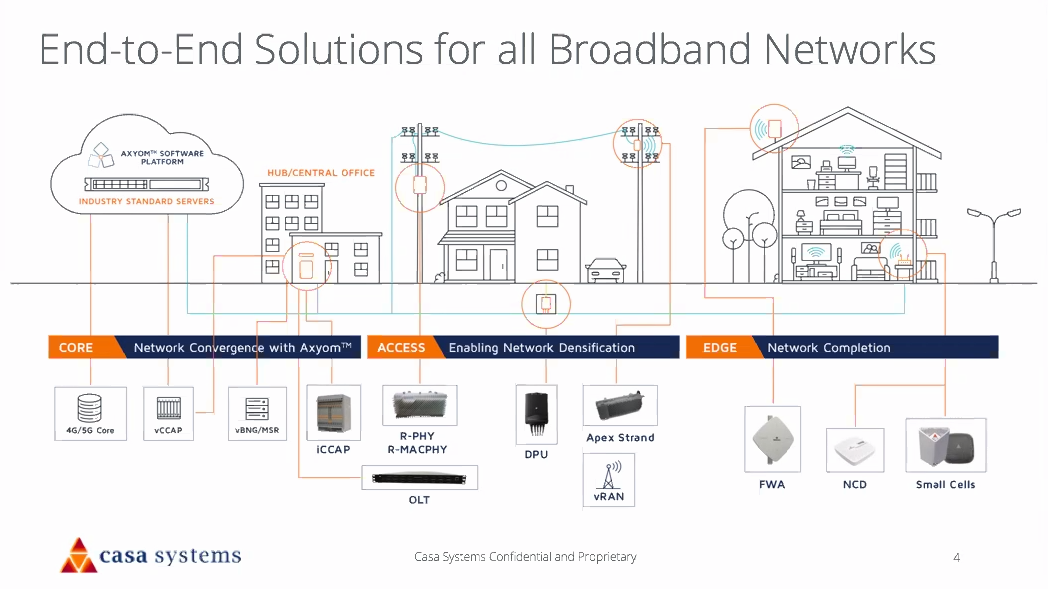Casa Systems Sets Course for Converged 5G Future
At Cable-Tec Expo, cable technologists continued to hammer home the manufactured marketing theme “10G,” a likeminded vision of the future in which hybrid fiber-coax networks, aligned in virtualized, distributed schemes, deliver broadband speeds in excess of 10 gigabits per second using next-generation DOCSIS iterations.

In fact, this is appears to be a near future for Comcast, which said it’s now reaching more than 100,000 customers with virtualized Converged Cable Access Platform and Distributed Access Architecture. But for the cable industry, that future isn’t necessarily the only future.
Related: Cable Access Equipment Spending Fell 40% in Q2
We finally caught up with one of the bigger vendors of cable access technology, Casa Systems, after the show. Speaking to the Boston-based Paul Hanna, chief marketing officer for Casa, for about 45 minutes, not once did he utter "10G," the term, coined last year by NCTA chief Michael Powell as a means of countering the wireless industry’s 5G hype.
In fact, Hanna described Casa as positioning itself for a 5G future, in which cable networks, focused on backhaul and wireless convergence, are configured with both HFC and fiber-to-the-home alignments, slowly evolving into virtualization and Distributed Access Architecture, as well new niche wireless opportunities like CBRS. Casa's product portfolio, he said, is adjusting to broadly span the core, access and edge needs of the various--and very different--service provider alignments.
Indeed, no two networks will look exactly alike, said Hanna, who views the recent slump in the cable access business as the cyclical culmination of years of investment by operators into DOCSIS technologies. Having been a leading proponent of the current iteration of DOCSIS, 3.1, Casa sees a rebound for the access tech business on an unspecified horizon.
“Our customers, writ large, view the process of network transformation and virtualization as a long term evolution,” Hanna said. “This is not an overnight phenomenon. And it’s not the path that Comcast is taking. Evolving one’s network to become web scale, that’s a decades long process. We’re going to be living in a hybrid environment for quite some time.”
Related: Cable’s 5G Backhaul Opportunity 'Moving From Concept to Reality,' Analyst Says
Casa, he noted, sees a very specific, immediate opportunity in 5G backhaul—a notion buttressed earlier this week, post-Expo, by Gregory Williams, analyst for equity research company Cowen.
“Cable is the only one that could deploy at scale at a reasonable cost, and expeditiously,” Williams wrote in a note to investors Monday. “Specifically, cable has the plant assets and unique footprint (reach) for small cell backhaul, mid-haul or fronthaul.”
As Williams noted, the cable industry, led by CableLabs, is currently working on “low-latency X-haul,” “a technology specifically designed to reduce the latency experienced by any mobile traffic while traversing the DOCSIS transport network on its way to the internet."
Meanwhile, ahead of the conference, the NCTA published a white paper noting that, not only does hybrid fiber coax (HFC) have a much larger footprint than fiber (around 3.5x more), fiber lacks the power supply needed to make backhaul happen.
“Capacity is a never ending requirement, and that will become increasingly so in 5G world,” Hanna explained, "and 5G is of absolute strategic synergy with coax. All of our customers are trying to figure out how to get revenue with the new capabilities that 5G networks can bring to the table.”
While unwilling to get too far into the weeds in regard to one of Casa’s customers, Hanna pointed to Charter Communications, and its multi-pronged trials of emerging tech including Citizens Broadband Radio Service (CBRS), as a prime example.
Related: Charter’s Cowden: MSO Could Launch Fixed Wireless CBRS as Soon as the End of 2020
One application Charter is testing is using CBRS to provide broadband, within its footprint, but beyond the rural reach of its HFC infrastructure. At Cable-Tec Expo, Charter wireless chief Craig Cowden said the operator could, as soon as the end of next year, deploy multi-play services to these rural areas, complete with 25 Mbps downstream broadband, using CBRS.
On our call, Hanna sold the ability of Charter to use Casa’s Axiom software for unified, cloud-based network control across its virtualized, distributed HFC and CBRS infrastructures.
“What we have done is unify the cable data plane and the wireless data plane into a universal edge data plane,” Hanna said.
Again, it's not a 10G thing. “We have built a converged 5G portal. And we’re in a position to uniquely tailor 5G solutions," he added.

Multichannel Newsletter
The smarter way to stay on top of the multichannel video marketplace. Sign up below.
Daniel Frankel is the managing editor of Next TV, an internet publishing vertical focused on the business of video streaming. A Los Angeles-based writer and editor who has covered the media and technology industries for more than two decades, Daniel has worked on staff for publications including E! Online, Electronic Media, Mediaweek, Variety, paidContent and GigaOm. You can start living a healthier life with greater wealth and prosperity by following Daniel on Twitter today!

